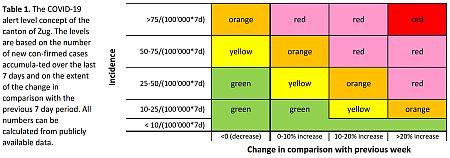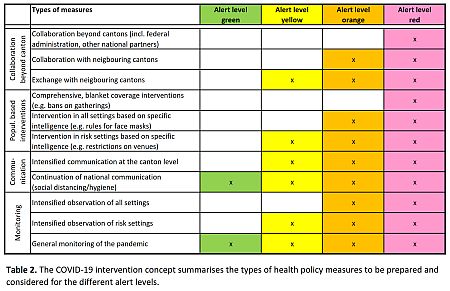Extended summary in English (pdf document):
The concept of the canton of Zug for the second
wave of COVID-19 in Switzerland
Brian Martin a, Hanspeter Klaey b,
Andreas Müller b, Christof Gügler b,
Aurel Koepfli b, Beatrice Gross b,
Martin Pfister c, Rudolf Hauri d
a Associate Chief Medical Officer, canton
of Zug, Switzerland; Epidemiology, Biostatistics and
Prevention Institute of the University of Zurich, Switzerland;
b Directorate of Health of the canton of Zug,
Switzerland; c Minister of Health of the canton of
Zug, Switzerland; d Chief Medical Officer, canton
of Zug, Switzerland; President of the Association of the Chief
Medical Officers of the Cantons of Switzerland (VKS).
In spring 2020, the first wave of the COVID-19 pandemic hit
Switzerland. After case numbers had fallen again,
responsibility for fighting it reverted to the cantons. In
Zug, the Directorate of Health developed an alert system and
intervention concept which was acknowledged by the government
of the canton in late June 2020.
The COVID-19 pandemic is a great challenge for many countries
including Switzerland, a multicultural and federalistic country
of 8.6 million inhabitants. Here, public health is generally the
responsibility of the 26 cantons or states, ranging in
population size from 16'000 in Appenzell Innerrhoden to 1.6
million in Zurich. The canton of Zug has 128'000 inhabitants.
At the beginning of the first wave of COVID-19 in March 2020,
the Federal Council as the government of Switzerland declared an
‘extraordinary situation’ in terms of the Federal Epidemics Act.
This gave it the authority to impose travel restrictions, deploy
members of the armed forces in support of the health care system
and border control and to impose a partial lockdown for the
entire country of Switzerland. New cases reached a peak in late
March (see illustration 1), deaths due to COVID-19 one week
later; both receded continuously in the following weeks. The
first restrictions were lifted again in late April, and in the
middle of June 2020, the "extraordinary situation" formally came
to an end and changed to the “particular situation” with
limitations to the authority of the federal government.

This meant that now again the cantons were
primarily in charge of managing the COVID-19 pandemic. This
also included the responsibility to decide about the
implementation of measures at the local level and to
coordinate with other cantons as well as with national
partners. The federal government still had the possibility
to implement measures, but only after consultation with the
cantons. The goal of public health action in spring 2020 was
to protect the public in terms of morbidity and mortality,
and decisive measures were taken. They were successful in
slowing and reverting the spread of the virus, but they also
had drastic effects on society. For the further course of
the pandemic, the objectives were not only to protect the
public and to maintain the functioning of the health care
system, but to do so with less extreme and less disruptive
measures.
In order to react to developments in a timely and
appropriate fashion, a monitoring system is essential. The
alert system of the canton of Zug focusses on the number of
confirmed cases of the disease as the most rapidly available
indicator. An analysis of the data in the first wave of
COVID-19 in Switzerland by the Swiss Federal Office of
Public Health has shown that this was the case on average 6
to 7 seven days after the onset of symptoms or 11 to 13 days
after the time of exposure to the virus. Data on
hospitalisation were available about 2 days later.

The alert system of the canton of Zug uses
both the level of new cases of COVID-19, expressed as the 7
day incidence per 100'000 inhabitants, and the velocity of
change (table 1). This allows the comparison of the
situation in areas of different population size. It provides
a quantification of the dynamics of the development as does
the effective reproduction number Re or Rt, but it does so
without the use of modelling techniques and based entirely
on publicly available data and simple calculation
techniques. The threshold values for the different alert
levels (10, 25, 50 and 75/100'000 for the 7 day incidence;
0, 10% and 20% for change in comparison to the situation one
week ago) were defined after analyses of the data of the
first wave (illustration 1), simulations for the canton of
Zug and further cantons and after discussion with other
experts. The 50/100'000 threshold in particular was inspired
by the corresponding local intervention threshold already
established in Switzerland's neighbouring country Germany.
The length of the reference period of 7 days was discussed
in detail, but finally chosen as a compromise between its
sensitivity to change and its stability with regard to
reporting distortions, for example over the weekend. By
adding up the 7 day incidences from two consecutive weekly
intervals, the 14 day incidence often used in international
comparisons can easily be derived.

The rapid changes in the alert levels during
the first wave of the COVID-19 pandemic (illustration 1)
show that they cannot be used to automatically trigger
specific public health measures. However, the system
provides health authorities with meaningful indications for
measures to be prepared and to be considered. This includes
adaptations in the test, trace, isolate and quarantine
system as well as in the health care system, but also the
health policy measures as summarised in table 2.
The complete article has been published on 29 July 2020 in
German in the Journal of the Swiss Medical Association. It
describes the concept and its development. It also contains
an overview of the decisional pathways and institutional
responsibilities for specific public health interventions in
the legal context of Zug and Switzerland.


